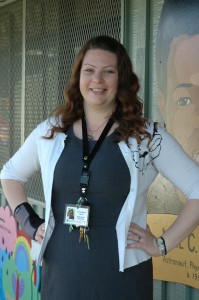
When we think about what schools can do to help students thrive, we don’t tend to conjure lessons in breathing. Taking in oxygen comes naturally to most of us, as does the movement of air out of our bronchial tubes and into the world around us. But for children with asthma, this natural rhythm is interrupted by indoor allergens like dust mites or mold, chemicals from the environment and pollutants from traffic. And if you can’t exhale, you can’t learn.
By the same token, cleaner air in school classrooms makes it possible for more students to breathe easier and stay in class.
Martin Luther King, Jr. Elementary in Oakland, California, offers proof that it’s possible to improve indoor air quality by assigning a committed staff person or two to the task and supporting them to lead others through a series of small steps.
Enter Max Gara, an Americorps VISTA member assigned to the Oakland Unified School District and Coreen Willard, RN, PHN, a school nurse who is one of more than 50 Wellness Champions – point persons on site at schools throughout the district who play a special role helping school wellness to take root.
Making wellness strides for students was part of Gara’s mission during his year of service in 2012-1013, and his approach to improving air quality was proactive. He gathered research, conducted presentations and trainings, devised checklists and had a knack for politely following up with very busy people. Gara and Willard joined forces to collect basic information about the location of asthma triggers at the elementary school. Through a survey to staff and during a school walk-through, their team identified areas with blocked ventilation, incorrect thermostat settings, air fresheners and chemical cleaners.
Then school staff cleared blockages, posted signs with tips for setting ventilation, and replaced chemical cleaners and sprays with mild products such as baking soda.
The forethought and collective effort are already paying off. Attendance rates among students with asthma have risen since the project began.
Parents are becoming more informed about potential asthma triggers in the home, too, and about resources available to families to manage asthma. Given that nearly one-third of the school’s students have asthma, these shifts could have a significant impact on the student body.
Willard serves as a school nurse at West Oakland Middle School and McClymonds High School in too, and she is helping to integrate a similar program at the middle school. These three schools have the highest rates of asthma in the entire district.
“School nurses provide training to school staff on the basics of asthma each year,” explains Willard. “But it was participation in the Air Quality Improvement program that really helped to drive those points home and get everyone thinking more about how they can improve the air quality at our school.”
Key challenges in sustaining the progress are making the time to monitor classrooms for asthma triggers, orienting new teachers to the protocol, and reminding teachers and staff of fixes that they can do on their own.
“Many changes are cheap and easy to make, but we need a person to monitor and keep awareness up. Having the nurse do wellness is great,” reports Principal Roma Groves.
The school is compiling teacher information packets to highlight simple solutions for maximizing air quality.
In Northern California, Kaiser Permanente began providing substantial funding to Oakland Unified School District in 2010 to promote physical activity and nutrition, implement school wellness policies, establish school-based health centers, and develop programs to meet the needs of students historically underserved by the educational system. A new $10 million grant was awarded in 2013 to continue and expand this work.




